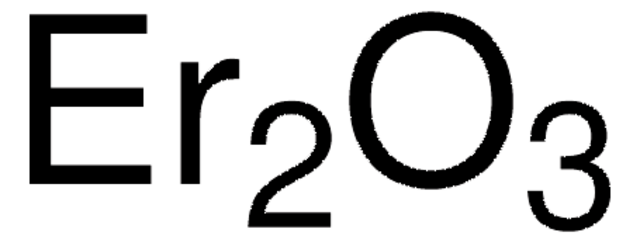544892
Yttrium(III) oxide
nanopowder, <50 nm particle size
Synonym(s):
Yttria
About This Item
Recommended Products
form
nanopowder
Quality Level
surface area
30-50 m2/g
particle size
<50 nm
mp
2410 °C (lit.)
density
5.01 g/mL at 25 °C (lit.)
SMILES string
O=[Y]O[Y]=O
InChI
1S/3O.2Y
InChI key
SIWVEOZUMHYXCS-UHFFFAOYSA-N
Looking for similar products? Visit Product Comparison Guide
Related Categories
Application
- Preparation and characterization of yttrium oxide nanoparticles at different calcination temperatures: This study examines the preparation methods and characteristics of yttrium oxide nanoparticles, highlighting their thermal stability and potential applications in various fields (AJ Abdulghani, WM Al-Ogedy, 2015).
- Water assisted atomic layer deposition of yttrium oxide: Describes the development and analysis of yttrium oxide thin films, essential for enhancing the performance of electronic and optical devices (L Mai, N Boysen, E Subaşı, T de Los Arcos, D Rogalla, 2018).
- Modification of stability properties of yttrium (III) oxide particles: Focuses on the stabilization of yttrium oxide particles for enhanced performance in environmental and technological applications (M Wiśniewska, K Herda, T Urban, P Nowicki, 2024).
- Gamma ray induced thermoluminescence studies of yttrium (III) oxide nanopowders: Investigates the thermoluminescent properties of yttrium oxide doped with gadolinium, relevant for radiation detection and dosimetry (RK Tamrakar, K Upadhyay, DP Bisen, 2014).
- Yttrium oxide nanoparticle synthesis: Provides an overview of the methods for synthesizing yttrium oxide nanoparticles and their biomedical applications, highlighting the material′s versatility and potential for future innovations (G Rajakumar, L Mao, T Bao, W Wen, S Wang, 2021).
Storage Class
13 - Non Combustible Solids
wgk_germany
WGK 1
flash_point_f
Not applicable
flash_point_c
Not applicable
ppe
dust mask type N95 (US), Eyeshields, Gloves
Certificates of Analysis (COA)
Search for Certificates of Analysis (COA) by entering the products Lot/Batch Number. Lot and Batch Numbers can be found on a product’s label following the words ‘Lot’ or ‘Batch’.
Already Own This Product?
Find documentation for the products that you have recently purchased in the Document Library.
Customers Also Viewed
Articles
The union of distinct scientific disciplines is revealing the leading edge of Nanotechnology.
As with all types of fuel cells, a Solid Oxide Fuel Cell (SOFC) is capable of efficiently transforming chemical energy into electrical energy.
Advanced Inorganic Materials for Solid State Lighting
Magnetic materials permeate numerous daily activities in our lives. They are essential components of a diversity of products including hard drives that reliably store information on our computers, decorative magnets that keep the shopping list attached to the refrigerator door, electric bicycles that speed our commute to work, as well as wind turbines for conversion of wind energy to electrical power.
Our team of scientists has experience in all areas of research including Life Science, Material Science, Chemical Synthesis, Chromatography, Analytical and many others.
Contact Technical Service









